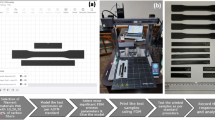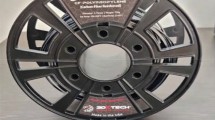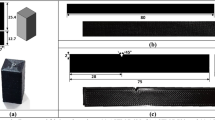Abstract
Fused deposition modelling (FDM) is one of the most sought-after techniques in the field of additive manufacturing for the fabrication of polymer composites. This article aims to augment the mechanical and tribological behaviour of polyamide 6 (PA6) reinforced with carbon fibre (CF) composite test samples were fabricated through the FDM process by changing the layer height considering it to be the most significant process parameter. The standard test samples were fabricated with various layer heights (0.08, 0.16, and 0.24 mm) while maintaining the other printing parameters at a fixed setting. Fabricated samples were subjected to hardness, tensile strength, impact strength, and flexural strength tests in addition the pin-on-disc tribometer test for evaluating wear rate and coefficient of friction. During the pin-on-disc experiment, the specimens were subjected to varying applied loads of 5 N, 10 N, 15 N, and 20 N with 1 m/s and 3 m/s as their sliding velocity, responses were recorded. On appraisal of the obtained responses, it was found that the samples with a minimum layer height of 0.08 mm showed better performance in terms of mechanical strength and tribological behaviour. The lower layer height seems to have high interlaminar strength and adhesion between the layers. Thus, the PA6 reinforced with 20 weight percentage carbon fibre composites fabricated through the FDM process by maintaining the layer height at 0.08 mm will be suitable for developing critical components for aerospace and automobile applications.







Similar content being viewed by others
References
J. Savolainen, M. Collan, How additive manufacturing technology changes business models?—Review of literature. Additive Manuf. (2020). https://doi.org/10.1016/j.addma.2020.101070
M. Chaudhari, B.F. Jogi, R.S. Pawade, Comparative study of part characteristics built using additive manufacturing (FDM). Procedia Manuf. (2018). https://doi.org/10.1016/j.promfg.2018.02.010
H. Bikas, P. Stavropoulos, G. Chryssolouris, Additive manufacturing methods and modelling approaches: a critical review. Int. J. Adv. Manuf. Technol. 83, 389–405 (2016). https://doi.org/10.1007/s00170-015-7576-2
M.S. Srinidhi, R. Soundararajan, K.S. Satishkumar, S. Suresh, Enhancing the FDM infill pattern outcomes of mechanical behavior for as-built and annealed PETG and CFPETG composites parts, in Materials Today Proceedings, vol. 45, (2021), https://doi.org/10.1016/j.matpr.2021.02.417.
D. Popescu, A. Zapciu, C. Amza, F. Baciu, R. Marinescu, FDM process parameters influence over the mechanical properties of polymer specimens: a review. Polymer Test. (2018). https://doi.org/10.1016/j.polymertesting.2018.05.020
Q. Sun, G.M. Rizvi, C.T. Bellehumeur, P. Gu, Effect of processing conditions on the bonding quality of FDM polymer filaments. Rapid Prototyp. J. 14(2), 72–80 (2008). https://doi.org/10.1108/13552540810862028
R. Singh, R. Kumar, I. Mascolo, M. Modano, On the applicability of composite PA6-TiO2 filaments for the rapid prototyping of innovative materials and structures. Compos. Part B Eng. (2018). https://doi.org/10.1016/j.compositesb.2018.01.032
M. Lay, N.L.N. Thajudin, Z.A.A. Hamid, A. Rusli, M.K. Abdullah, R.K. Shuib, Comparison of physical and mechanical properties of PLA, ABS and nylon 6 fabricated using fused deposition modeling and injection molding. Compos. Part B Eng. (2019). https://doi.org/10.1016/j.compositesb.2019.107341
R.Soundararajan, Thangaraj, Hari, Vasudevan, Aravind, Shanmugan, Dharshan, Analogy of thermal properties of polyamide 6 reinforced with glass fiber and glass beads through FDM Process, Published October 11, 2019 by SAE Technical Paper, (2019) https://doi.org/10.4271/2019-28-0137 .
P. Chen, H. Wu, W. Zhu, L. Yang, Z. Li, C. Yan, S. Wen, Y. Shi, Investigation into the processability, recyclability and crystalline structure of selective laser sintered Polyamide 6 in comparison with Polyamide 12. Polymer Test. (2018). https://doi.org/10.1016/j.polymertesting.2018.05.045
X. Yang, Z. Wang, M. Xu, R. Zhao, X. Liu, Dramatic mechanical and thermal increments of thermoplastic composites by multi-scale synergetic reinforcement: Carbon fiber and graphene nanoplatelet. Mater Design (2013). https://doi.org/10.1016/j.matdes.2012.07.051
S.-S. Yao, F.-L. Jin, K.Y. Rhee, D. Hui, S.-J. Park, Recent advances in carbon-fiber-reinforced thermoplastic composites: a review. Compos. Part B Eng.Eng (2018). https://doi.org/10.1016/j.compositesb.2017.12.007
W. Liu, L. Li, S. Zhang, F. Yang, R. Wang, Mechanical properties of carbon nanotube/carbon fiber reinforced thermoplastic polymer composite. Polym. Compos.. Compos. (2015). https://doi.org/10.1002/pc.23771
J.G. Díaz-Rodríguez, A.D. Pertúz-Comas, O.A. González-Estrada, Mechanical properties for long fibre reinforced fused deposition manufactured composites. Compos. Part B Eng. (2021). https://doi.org/10.1016/j.compositesb.2021.108657
S. Dev, R. Srivastava, Experimental investigation and optimization of FDM process parameters for material and mechanical strength, in Materials Today Proceedings, vol. 26, (2020), https://doi.org/10.1016/j.matpr.2020.02.435.
S. Singh, R. Singh, Experimental investigations for use of nylon6 industrial waste as FDM feedstock filament for investment casting applications. Indian J. Eng. Mater. Sci. 23, 181–187 (2016)
S. Renganathan, D. Saritha, Effect of fill pattern and printing speed on friction characteristics of FDM printed polylactic acid polymer. Adv. Mater. Process. Technol. (2021). https://doi.org/10.1080/2374068X.2021.1948707
H. K. Dave, N. H. Patadiya, A. R. Prajapati, S. R. Rajpurohit, Effect of infill pattern and infill density at varying part orientation on tensile properties of fused deposition modeling-printed poly-lactic acid part, in Proceedings of the Institution of Mechanical Engineers, Part C: Journal of Mechanical Engineering Science, (2021), vol. 235, pp. 1811–1827. https://doi.org/10.1177/0954406219856383.
D. Akhouri, D. Karmakar, D. Banerjee, S. Mishra, Various infill patterns and their effect in 3D printable materials. Int. J. Innov. Sci. Res. Technol. 6(9), 538–542 (2021)
Öteyaka, M. Özgür, F.H. Çakir, M.A. Sofuoğlu, Effect of infill pattern and ratio on the flexural and vibration damping characteristics of FDM printed PLA specimens. Mater. Today Commun. (2022). https://doi.org/10.1016/j.mtcomm.2022.104912
S Ranganathan, K Kumar, S Gopal, C Pradeep, The effect of print orientation and infill density for 3D printing on mechanical and tribological properties in SAE Technical Paper, (2020), https://doi.org/10.4271/2020-28-0411.
R. Soundararajan, E. Dharunprakash, N. Arjunkumaar et al., Appraisal of mechanical and tribological performance of onyx and carbon fiber composites produced through various layering approaches in continuous fused filament fabricated. J. Inst. Eng. India Ser. D (2024). https://doi.org/10.1007/s40033-023-00626-z
N. Karthick, R. Soundararajan, R. Arul et al., Evolution of tribological performance of polypropylene with carbon fibre composites fabricated through FDM technology by varying infill density. J. Inst. Eng. India Ser. D (2023). https://doi.org/10.1007/s40033-023-00503-9
Funding
The authors declare that no funds, grants, or other support were received during the preparation of this manuscript.
Author information
Authors and Affiliations
Corresponding author
Ethics declarations
Conflict of interest
The authors declare that there is no conflict of interest.
Additional information
Publisher's Note
Springer Nature remains neutral with regard to jurisdictional claims in published maps and institutional affiliations.
Rights and permissions
Springer Nature or its licensor (e.g. a society or other partner) holds exclusive rights to this article under a publishing agreement with the author(s) or other rightsholder(s); author self-archiving of the accepted manuscript version of this article is solely governed by the terms of such publishing agreement and applicable law.
About this article
Cite this article
Sharvesh, R., Babu, M. & Soundararajan, R. Appraisal of Mechanical and Tribological Behaviour of Polyamide 6 with Carbon Fibre-Filled Composites Fabricated Through Fused Deposition Modelling. J. Inst. Eng. India Ser. D (2024). https://doi.org/10.1007/s40033-024-00735-3
Received:
Accepted:
Published:
DOI: https://doi.org/10.1007/s40033-024-00735-3




